
Recently on Cyclingnews.com |
Tales from the people's peloton
Never say never again
Following the route of stage 16 of this year's race, the Tour's people's event, l'Etape du Tour, was a serious test for the 8,000 riders who set out from Pau on July 16. Mark Sharon rode his ninth Etape this year and swore blind, for the ninth time, that he was not going to do it again.
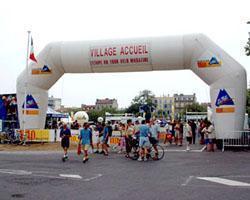 |
L'Etape du Tour, which means literally "Stage of the Tour", is organised by Velo Magazine. Velo is part of the ASO (Amaury Sport Organisation) media conglomerate that runs the Tour de France itself and a stablemate of the great sports newspaper L'Equipe. Each Etape follows the route of a stage of that year's Tour de France and just as no two courses of the Tour de France are the same, every L'Etape du Tour follows a different course each year. This year it followed the route of Stage 16, 201.9km, between Pau and Bayonne - a stage that Lance Armstrong said would be one of the toughest. I can confirm that Lance was spot on.
I enjoy everything about the Etape except the bit that lies between the Ligne de Depart and Ligne d'Arrivee. Actually that's a lie; I actually quite enjoy the last kilometre too. The rest is a test of mind over matter - a battle of gravity over mid-riff, of keeping a couple of square centimetres of rubber out of the countryside. Throw in a mixed bag of aching back, cramps, and spending ten hours drinking and eating a revolting mix of sugary drinks and glutinous energy bars and you have to ask yourself, "am I sane?"
Each year for nearly a decade I have arrived at the finish several pounds lighter than I started, streaked with grease, blood and other unmentionables, preparing to swear on oath that I will never, never do it again. Twelve months later, I find myself at another start line asking myself what on earth I am doing here?
So why do the Etape? Just as the Tour de France attracts the most diverse audience of any single sporting event, so everyone has their reason. There is the chance to match yourselves up against the professionals, under the same conditions. You can ride like the clappers on closed roads without the risk of becoming a trophy on a Dutch campervan. For some there is the chance to beat some former winners of the Tour at their own game - more of that later. For a tiny minority there is a chance you might win.
Coming back time and time again is something different. Someone likened doing the Etape to childbirth: as soon as it is over you seem to forget just how horrible it was, and you want to do it all over again. In my case my memory fails, and I get broody, as soon the route of the Tour de France is announced. I blame it on the phone calls. I will be innocently minding my own business when the phone will go and without even a word of hello the caller will demand, "which stage do you think it will be?"
 |
For the next month speculation amongst would-be Etapeurs is rife - everyone has their view, and the debate over the chances of one stage over another continue fiercely until a month later Velo makes its official announcement. Once the magnitude of the task ahead has been absorbed then it's a long wait until February when registrations open and you can sign up for another tour of duty.
Of course, worse even than not finishing the race itself is the prospect of not even starting it. The number of participants is limited to 8,000 to minimise overcrowding, but many thousands more than that apply. Speed is of the essence if you want to secure a place because this year every slot went inside the first week. Even more competitive is the fight for accommodation, which starts way back when the Tour route is announced with people taking speculative positions on hotel places. If you wait to book a place when your entry is confirmed you might find yourself having to pitch a tent somewhere many miles from the start.
With accommodation and entry confirmed all you have to do is spend the next six months honing your body to perfection while eating, dreaming and talking cycling.
Getting it all together
Anybody who has watched the TV programme the A-Team will be familiar with John 'Hannibal' Smith's immortal catchphrase - "I just love it when a plan comes together".
I was pondering this thought on the start line, with some degree of amazement. In common with most riders who don't live on the doorstep of the race, the Etape is an exercise in meticulous planning for me - bike, training, nutrition, clothing, transport and accommodation, have to come together so you arrive for the 7.00 start refreshed, fit, hydrated, with a bike that just purrs with perfection. All of this has to be achieved while juggling family and work life, bike shops in a rush, airlines hitting the holiday season and eating in three different restaurants a day. Yet here I was probably 99 percent ready for action.
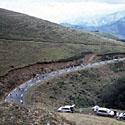 |
Some of my friends at the race had not such an easy time of it. Marcus Broome, a 6ft 3in ex-rower has had to replace his back wheel the day before the race. Another pal, Simon Cole discovered on arrival at Bordeaux airport that his bike was still back in the UK. The next 24 hours until it finally arrived were a little tense. Marcus's friend Glyn has the air of a man who has seen all this before despite it being his first Etape.
Simon then discovered his rear hub was entirely grease-free despite being serviced the week before by a well known London bike shop. A morning spent at Cycles Arbes in Lourdes, owned by Hubert Arbes a former team-mate of Bernard Hinault, left him a couple hundred of Euro poorer but with a shiny new wheel.
I took advantage of the opportunity to sort out a funny little tink-tink noise that another well-known bike shop had failed to eliminate despite having my bike for a week. Cause: one chain-link too many bringing the derailleur too close to the sprocket. Time to detect the problem: 20 seconds, tops. Time to solve: five minutes. Result: purrrrrr! It was worth the price of Simon's wheel to watch how a real mechanic sorts out a bike.
Then it was off to the Start Village to pick up race numbers. Each Etape is preceded by two days of events centred on the Start Village. There you meet up with old friends, pick up your race pack, shop at the sponsors’ stands. The two days culminate in a pasta party for four thousand people.
Fast forward to the start line and my mind is on the challenge we are facing. The finish might be at sea-level, but the intervening 201.9km include a brace of first category climbs, the Col de Soudet (1540 metres) and the Col Bagargui (1327 metres). Mixed in with them were a couple of third category and a couple of fourth category climbs for a total of 3930 metres of ascent.
 |
Fortunately the weather conditions had turned in our favour. On the Sunday before I had reconnoitred the Col du Soudet in conditions akin to standing in front of a hot oven. At one point the temperature gauge on my heart rate monitor stated 38°C. At least four times I took shelter in the shade, grovelling for breath. Now, on the morning of the race, to everyone's relief it was if anything a tad cool.
We have some illustrious company for this race the tenth anniversary edition. It is Miguel Indurain's birthday and he has made the short journey from Pamplona to celebrate it with a bike ride. Abraham Olano is also at the head of the field, alongside Christophe Rinero who won the first Etape du Tour back in 1995. There is also former F1 Grand Prix champion Alain Prost. Before you write him off as just another VIP, you might want to know that one year he came in 42nd!
Those of you who have studied the official race profile will notice that I appear to have overstated the distance of the race by a few kilometres. The professional stage is listed as 197.5 km, but don't forget the neutralised zone. We amateurs on the other hand don't get to parade out of town waving to the townsfolk. No, it is eyeballs out from the start!
Target: 30km/h
Being at the start of an Etape is like being a bull at La Fiesta de San Fermin - a case of you are with us or you are road-kill. It's a very dangerous phase and no self-respecting Etape goes off without a pile-up in the first few kilometres. Post-race feedback confirmed this start was true to form.
The normal collective anxiety is exacerbated by the fact that the organisers have defined two elimination points along the route. If you are not averaging at least 18km/h at these points you are out of the race. That doesn't sound so bad, except the small matter of there being a very big hill before each elimination point. Based on my performance a couple of days before I would be history at the first one.
With this prospect looming we have psyched ourselves up to fever pitch calculating the average speeds we would need at each point. In my case I need to be doing 30km/h when I hit the foot of the Col de Soudet.
It is hard to tell how fast we are going. My computer isn't working, probably because the sensor and magnet are too far apart. I have two choices, stop and sort it out, thereby risking immediately death by peloton, or soldier on. I try to adjust the position of the sensor in flight but it slips down the fork and jama at the bottom. Mercifully it doesn't slip into the wheel. At the foot of the fourth category Côte des Créts, 20km into the race I risk a short stop to deal with the computer, before rejoining the melee.
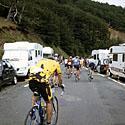 |
My group covered the first 58km to the foot of the Col de Soudet at an average of 35 km/h. I think everyone was a little surprised, and this was summed up by an American who was heard to say, "we're early!" After a frantic feed stop I steeled myself for the ascent. I pass large yellow sign proclaiming "Vous êtes á 150km de l'Arrivee" - thanks for telling us.
Ahead lie 14km of climbing at an average of 7.5 percent. Averages are deceptive. I already know that some sections rear up to a knee-breaking 15 percent, while the final three kilometres are almost on the level. On the other hand without the furnace-like conditions of my training ride weather I won’t be facing rapid dehydration. After, the first few corners I know that barring incident I will make it to the top in a respectable time.
One of the first things that strikes you about a climb in the Etape is how quiet it is, apart from the rasp of breath and the creak of bikes. Talking subsides, except perhaps from some joker who sings his way up. Occasionally a Mavic mechanic steams by on motorbike or a Croix Rouge van roars up sirens wailing. Otherwise everyone is in a world of their own. It is still relatively crowded however and that brings its own problems as faster riders try to find gaps around the slower ones.
Suddenly I hear a crash and shouts of "putain" just behind me. I dare not look back though because at 10km/h I am liable to veer across the road at the slightest shift in weight.
The summit feeding station is a welcome sight, though it looks like a colony of gannets have attacked a supermarket. Plastic mineral bottles carpet the road. Everyone is having to struggle through on foot risking life and limb on the discarded orange peel and energy bar wrappers. A heavy press motor-bike suddenly skids and topples over throwing the pilot and his passenger to the ground and crushing someone's bicycle.
Going down
It is a relief to escape and start the descent with my pockets jammed full of water bottles and food. I lied when I said I didn't enjoy the Etape, because where else can you descend like a demon in a car-free environment, the wind rushing through the air vents of your helmet (not forgetting to do the strap up after the climb of course), and the swish of tyres on the road?
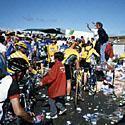 |
Gravity has a way of imposing itself on you. You can't fight it; you just try to manage it. It means utmost faith in your equipment choice - in my case this is Michelin Pro Race tyres and Campagnolo Record brakes. Everything else is just something to sit on and enjoy the ride. My Principia REXe frame does a surprisingly good job of absorbing the bumps, despite its straight-line stiffness, aided and abetted by an Easton CT2 carbon seat post. [That's enough blatant product-placement - Ed]
The descent does have its interesting moments. Ahead of me there is a loud bang as someone's back tyre explodes. He does a remarkable job of keeping himself upright as he hurtles on to the verge and stops. I pass and detect the distinct smell of over-heated rim.
I reach the valley floor feeling a mixture of relief and trepidation, and not a little battered from my headlong descent. As always my hands ache from pumping the brake levers. The trepidation has a lot to do with what's looming up ahead: the Col Bagargui. In Sainte Engrâce we bump over the timing mat marking the first Zone d'Elimination. I note that I am more than an hour inside the cut-off time.
Ahead of the Col Bagargui is the fierce little ascent of the Côte de Larrau - it may be small but it can sure pack a punch. Just 2 km long it averages 10.5 percent. In hot weather it could have been a nightmare, but today it was a matter of gritting one's teeth and grinding it out.
At the bottom of the Col Bagargui is a sign with the profile of the climb - my advice is don't look at it. Keep your eyes firmly on the road. I made the mistake of glancing at it - it was the briefest of glances but it was enough for me to see a collection of 11's, 12's and a 13, amounting to 8.8km at an average of 9.2 percent. My triple chainset was about to get a severe workout.
I have to admit the climb was hard; very, very hard. You watch the professionals dance their way up such climbs just about breaking sweat. It's not until you are doing it yourself that you realise that they are suffering at the limit of their strength - they are just good at not showing it. The compensation is the view, a marvellous vista of green mountains as far as the horizon.
I gain momentary relief from my toils due to a friend's misfortune. Simon Cole has been decked by a rider who stopped right in the middle of the road and clipped Simon's wheel. His cleat has detached from the shoe and is still stuck in the pedal and he has spent twenty minutes trying to lever it free. Fortunately I have just the tool and soon he is back on the road. The challenge is getting myself going again on such a steep gradient.
Summit fans
 |
Near the top of the climb the scene is just like the Tour de France. Campervans and cars line the road, and a cheering crowd is urging on the riders with chants of "Allez! Allez!" Most of them seem to be friends and relatives of riders in the race, but their support was spread generously through out the peloton. At one point I struggle to regain momentum after taking a picture, and a find myself being propelled up the road by a hand on the back of my saddle.
My wife calls me on the mobile to which I am connected via an ear-plug – á la the pros. I gasp out that I have just a few hundred metres to go, and that it has been very difficult. Then I utter those words which send her into fits of laughter: "Please don't let me ever do this again." When she hangs up someone asks if I have been talking to my Directeur Sportif. I tell them, "Oui, ma femme," to their amusement.
At the Ravitaillement on the summit I spend the barest time getting my breath back, grab some food and drink and launch myself downhill. By now the great peloton has thinned out substantially and I am able to better choose my line in and out of corners.
There is a rude shock just a few kilometres down the track. I'd forgotten about the unpronounceable Col de Burdincurutcheta. Well, it is difficult to say with a mouthful of energy bar. Short but steep it holds up proceedings for a while as I re-engage climbing mode.
 |
In your race pack they give you handy little race profile with the itinerary. Unfortunately, it was still in my race pack waiting for me in Bayonne. At the summit of the Burdincurutcheta I ask someone for a distance check. I digest the news we are still 80 kilometres from the finish - hardly 'job done' despite the worst bit being over.
From the profile it looks like a series of lurches towards sea-level, but reality is something else. Fortunately the first section is a long fast descent. The roads are beautiful and wide, and we descend through dense woods.
As we start to level off Marcus Broome, who passed me on the ascent to Bagargui pulls alongside and announces we have a problem. Our colleague Glyn has crashed on the descent of Bagargui. It seems he got caught up on a corner and went flying. Marcus is understandably shaken up by the news, but I am reassured by the fact that Glyn made the phone call himself. We find Glyn with the Red Cross in St Jean le Vieux receiving a set of stitches. Needless to say his race is over for this year.
Flat mixed blessing
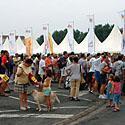 |
Belying the terrain to come we have a long section of flat roads. It's a mixed blessing as we are also exposed to a strong headwind coming of the distant sea. It's time to see if we can gather a group together, and soon Marcus and I are part of a little bunch of some eight to ten riders flying along at 40km/h.
On the flat I am feeling pretty strong, but then we hit a series of hills and I realise my legs are running out of power. These are not the long drags of earlier in the race, but the sort of relatively short ups and downs that characterise my training routes in the North Downs of Surrey. Ten to fifteen minutes apiece they sap energy quickly, and it is amongst these I lose contact with Marcus.
I am far from being alone though and I manage to latch on to the back of a sizeable group. Nestled in the middle the group I hardly have to pedal to keep going. The group maintains a degree of integrity for nearly fifteen kilometres giving everyone, except the poor mug on front, a degree of respite.
Ten kilometres from the finish it was back to everyone for themselves, as the steep climb to Mouguerre scattered the group along the road in pairs and singles. It was redundant now anyway as from the summit it was downhill to the riverside in Bayonne then a scant three kilometres to the finish. I felt so close I hardly needed to draw breath, but I couldn't relax until I could see the finish line arch in the distance.
The TV commentators kept referring to the finish as a tough little climb of 400m but they hadn't just survived ten hours and 201.9 kilometres of mountains. Just the mere fact that on the other side of that finish line was a beer tent drove me up that hill as if on wings.
For the record I came 5117th in 9 hours 58 minutes. Simon Cole finished in 9 hours 36 minutes, while Marcus Broome finished in 9 hours 40 minutes.
What of our contingent of celebrities? Miguel Indurain didn't finish the race. He climbed off at Larrau at the half way point. Abraham Olano arrived in 79th place with a time of 6 hours 51 minutes, while Alain Prost came 203rd with a time of 7 hours 9 minutes. The winner was Loic Herbreteau with a time of 6 hours 17 minutes.
Postscript
I left writing this piece until the professionals had tackled the same stage. When it was won by Tyler Hamilton I knew instantly I was in the right job. Tyler's winning time of 4 hours 59 minutes and 41 seconds was almost precisely half of my own - an average speed of 40km/h across two first category climbs! Not bad for a man with a broken clavicle.
What's absolutely amazing is the margin of 1 hour 18 minutes by which he beat the winner of the Etape du Tour. In fact, as I write this the entire peloton of the Tour de France has finished nearly an half an hour faster than the Etape.
